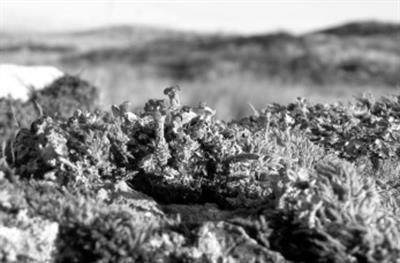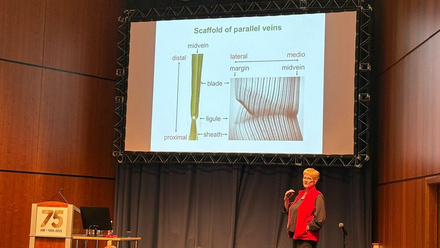Anhydrobiosis—pushing the limits of desiccation tolerance
Anhydrobiosis—pushing the limits of desiccation tolerance
All life needs water to live. This simple yet essential biological paradigm causes human settlements to develop alongside water bodies and motivates NASA to ‘follow the water’ when hunting for extraterrestrial life. However, certain life forms on Earth seem to waive this basic rule and survive under the most extreme arid conditions. They enter a state called ‘anhydrobiosis’, derived from the Greek for ‘life without water’, in which metabolism temporarily comes to a halt.
SURVIVAL THROUGH SYMBIOSIS—A PROBLEM SHARED IS A PROBLEM SOLVED
Lichens are such a masterpiece of evolutionary adaptation. These humble-looking creatures colonise widely diverse ecosystems from the artic tundra to hot and dry deserts, and they can grow on almost any surface, however marginal it may be. They are symbiotic organisms consisting of photosynthetically active microalgae or cyanobacteria that live among the filaments of fungi. In this mutualistic relationship, the phycobiont produces carbohydrates that are absorbed by the mycobiont, which in turn provides shelter, water, and nutrients, and facilitates anchoring on surfaces. This close partnership allows lichens to be more than the sum of their parts and to conquer ecosystems outside of each partner’s individual ecological range—or to patiently endure being sent to space, bathed in liquid nitrogen, or washed with acetone by inquisitive scientists. Lichens are poikilohydric, that is, they cannot actively regulate their water status, and are consequently challenged by rapidly and profoundly changing water contents. Their desiccation tolerance allows them to survive in equilibrium with extremely low air humidity, even if this means drying out until virtually no cytosolic bulk water and metabolic activity is left. In this ‘vitrified’ phase, the cytoplasm adopts a so-called glassy state: the cellular components are densely packed and show little movement while simultaneously maintaining the physical properties of a liquid. Upon rehydration lichens quickly absorb water, as much as 2000% of their dry weight. This spontaneous revival obviously necessitates special physiological adaptations and protective mechanisms. For example, synthesis of dehydrin proteins protects from desiccation-induced intracellular molecular damage, and an efficient antioxidant system minimises oxidative stress. Yet, little is known so far about the biophysical and biochemical processes that take place during vitrification. Therefore, Carniel et al. (2021) ask ‘How dry is dry?’ in their latest publication in JXB and unravel the minutiae of cellular processes during the transition from liquid to desiccated.1 Gradually equilibrating lichens at decreasing air humidity allowed them to determine the intracellular water content at which molecules in the highly viscous cytosol become immobile and enzymatic activity consequently ceases. They assessed molecular mobility using dynamic mechanical thermal analysis, a technique commonly used to define the viscoelastic properties of polymers, that is, whether a material shows ‘rubbery’ or ‘glassy’ behaviour. Measuring the enzymatic activity in vivo, or rather the absence thereof, was more challenging, because wet lab experiments and dried-up lichens are somewhat contradictory. Instead, the concentrations of the substrate and product of an enzymatic reaction were quantified at several points during desiccation, and their relative changes served as proxy for the enzymatic activity. The authors found that the critical point at which the cytosol turned from rubbery to glassy lay in the range between 35% and 55% relative air humidity when the lobes contained only 0.08–0.12 g H2O/g dry weight. For comparison, this is about as dry as a sheet of writing paper. Detrimental effects on physiological parameters such as contents of photosynthetic pigments or fatty acids were not detected during this process—the lichens were hence all set and ready to quickly resume efficient metabolic activity upon rehydration. Lichens could even be revived after being stored for several months at 5% relative humidity with water contents as low as 0.03 g H2O/g dry weight without showing signs of long-term impairment, once again confirming their hardiness. However, being ‘dry’ or being ‘really dry’ is a life-and-death issue for lichens: extended periods at slightly higher relative humidity caused substantial and irreversible damage to the phycobiont because deleterious biochemical processes can still take place in the rubbery state. The formation of intracellular glasses is therefore crucial and the secret behind the exceptional gift of extreme desiccation tolerance in lichens.
THRIVING AND SURVIVING

Some vascular plants that are adapted to highly variable water availability have evolved very different types of survival strategies. To withstand and quickly recover from extreme desiccation, these so-called resurrection plants have evolved vaired morphological and physiological mechanisms. One protective anatomical feature that several desiccation-tolerant species have in common is very thick cell walls that maintain their structural integrity when water is lost from the cell wall matrix and the cytosol. However, thicker cell walls pose a barrier for CO2 diffusion into the leaf to the intracellular chloroplasts and might consequently limit photosynthetic performance under well-hydrated conditions. In their latest article in JXB, Nadal et al. (2021) studied this potential trade-off between cell wall thickness and photosynthetic capacity. Surprisingly, they did not find lower CO2 assimilation rates in desiccation-tolerant compared to desiccation-sensitive species. Some resurrection ferns even showed higher photosynthetic rates than their desiccation-sensitive counterparts. Detailed study of the internal leaf anatomy revealed unique differences between the groups—resurrection plants not only have remarkably thick cell walls, but the arrangement of their photosynthetic cells allows for greater exposure to internal air spaces and consequently higher surface area for CO2 diffusion to chloroplasts per leaf area. Resurrection plants thus combine particular structural features that confer protection against stress without compromising photosynthesis under optimal growth conditions—an ideal adaptation to habitats where rapid dehydration and rehydration cycles occur. High stress tolerance whilst maintaining optimal productivity is also a desired trait for the development of new crop varieties. Understanding and learning from nature’s bag of tricks is a crucial step on the way towards more resilient crops.
How other species cope with conditions that are hostile to life can be explored in JXB’s Special Issue, ‘Green Life in Extreme Environments’.3
1. Carniel FC, Fernandez-Marín B, Arc E, et al. 2020. How dry is dry? Molecular mobility in relation to thallus water content in a lichen. J Exp Bot 72:1576–1588.
2. Nadal M, Perera-Castro AV, Gulías J, et al. 2021. Resurrection plants optimize photosynthesis despite very thick cell walls by means of chloroplast distribution. J Exp Bot: erab022, https://doi.org/10.1093/jxb/erab022
3. Special Issue: Green Life in Extreme Environments. J Exp Bot: 71, Issue 13. https://academic.oup.com/jxb/issue/71/13





